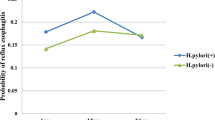Abstract
This study set out to investigate the effects of omeprazole or ranitidine on the progression of antral gastritis andHelicobacter pylori in patients with active duodenal ulcer. A double-blind, double-dummy trial was performed in 270 patients, 241 of whom were studied histologically for the presence ofH. pylori. Patients were randomized to receive omeprazole, 10 mg every morning, omeprazole, 20 mg every morning, or ranitidine, 150 mg twice a day, for four weeks. Endoscopy was performed on entry and at weekly intervals during the study; at least two antral biopsies were taken on each occasion to assess the activity and degree of chronic inflammation, as reflected by the degree of polymorphonuclear leukocyte infiltration and mononuclear cell infiltration, respectively. Biopsy specimes also were assessed histologically forH. pylori. The sex, age and maximal acid output were comparable in the three treatment groups. The percentages of patients showing an improvement in the activity of gastritis in the four consecutive weeks of treatment were 9%, 40%, 51%, and 53% for omeprazole, 10 mg (N=78); 14%, 42%, 49%, and 53% for omprazole, 20 mg (N=81); and 2%, 23%, 30%, and 33% for ranitidine, 150 mg twice a day (N=82) (life table analysis gaveP<0.01 for both omeprazole regimens compared with ranitidine). The degree of chronic inflammation showed similar changes. The density ofH. pylori decreased significantly after treatment with omeprazole, 10 mg or 20 mg, (both,P<0.00001) but not with ranitidine. The reduction in bacterial density was significantly higher (P<0.003) in those who showed improvement of gastritis than in those who did not. We conclude that effective acid inhibition with omeprazole improves antral gastritis and is accompanied by a reduction in antral bacterial density, suggesting that both acid andH. pylori may be involved in the pathogenesis of antral gastritis.
Similar content being viewed by others
References
Hui WM, Lam SK, Ho J, Ng MMT, Lui I, Lai CL, Lok ASF, Lau WY, Poon GP, Choi S, Choi TK: Chronic antral gastritis in duodenal ulcer, natural history and treatment with prostaglandin E1. Gastroenterology 91:1095–1101, 1986
Faber RG, Hobsley M: Basal secretion: Reproducibility and relationship with duodenal ulceration. Gut 24:909–913, 1983
Johnston BJ, Reed PI, Ali MH:Campylobacter-like organisms in duodenal and antral and antral endoscopic biopsies: Relationship to inflammation. Gut 27:1132–1137, 1986
Wallmark B, Sachs G, Mard S, Fellenius E: Inhibition of gastric (H+, K+)-ATPase by the substituted benzimidazole, picoprazole. Biochim Biophys Acta 728:31–38, 1983
Berglindh T, Sachs G: Emerging strategies in ulcer therapy: Pumps and receptors. Scand J Gastroenterol 20(suppl 108): 7–14, 1985
Walt R, Gomes M De FA, Wood EC, Logan LH, Pounder RE: Effect of daily oral omeprazole on 24-hour intragastric acidity. Br Med J 287:12–14, 1983
Nielsen AM, Stenderup J, Wandall JH, Bonnevie O: Reduction of gastric acid secretion by 10mg and 30mg omeprazole once daily. Scand J Gastroenterol 20:1236–1238, 1985
Baisco G, Miglioli M, Barbara L, Corinaldesi R, Di Febo G: OmeprazoleHelicobacter pylori, gastritis and duodenal ulcer. Lancet 2:1403, 1989
Unge P, Gad A, Gnarpe H, Olsson J: Does omeprazole improve antimicrobial therapy directed towards gastricCampylobacter pylori in patients with antral gastritis? Scand J Gastroenterol 24(suppl 167):49–54, 1989
Lamouliatte H, de Mascarel A, Megraud F, Barberis C, Bernard PH, Quinton A: Omeprazole improves amoxicillin therapy directed towardsHelicobacter pylori associated chronic gastritis. Gastroenterology 98:A75, 1990
Ghelan AM, Hale S, Coleman H, Radziwonik H: Lack ofin vitro activity of omeprazole againstCampylobacter pylori. J Clin Pathol 43:171–173, 1990
Lam SK, Lau WY, Choi TK, Lai CL, Lok ASF, Hui WM, Ng MMT, Choi SKY: Prostaglandin E1 (misoprostol) over-comes the adverse effect of chronic cigarette smoking on duodenal ulcer healing. Dig Dis Sci 31(suppl):68S-74S, 1986
Lam SK, Koo J: Accurate prediction of duodenal ulcer healing rate by discriminate analysis. Gastroenterology 85:403–412, 1983
Hui WM, Lam SK, Lau WY, Branicki FJ, Lai CL, Lok ASF, Ng MMT, Fok PJ, Poon GP, Choi TK: Omeprazole and ranitidine in duodenal ulcer healing and subsequent relapse: A randomized double-blind study with weekly endoscopic assessment. J Gastroenterol Hepatol 2(suppl 2): 35–43, 1989
Ho J, Lui I, Hui WM, Ng MMT, Lam SK: A study on the correlation of duodenal-ulcer healing withCampylobacter-like organisms. J Gastroenterol Hepatol 1:69–74, 1986
American Armed Forces Institute of Pathology: Warthin-Starry method for spirochaetes and Donovan bodies.In Manual of Histologic Staining Methods, G. Lee, HT Luna (eds) Bakiston Division, McGraw Hill, New York, 3rd ed. 1968, pp 238–240
Hui WM, Lam SK, Chau PY, Ho J, Lui I, Lai CL, Lok ASF, Ng MMT: Persistence ofCampylobacter pyloridis despite healing of duodenal ulcer and improvement of accompanying duodenitis and gastritis. Dig Dis Sci 32:1255–1260, 1987
Snedecor GW, Cochran WG: Statistical Methods, 6th ed. Ames. Iowa, Iowa State University Press, 1967
Fleiss, JL: Statistical Methods for Rate and Proportions. New York: Wiley, 1973
SPSS-X, User's Guide: Survival Analysis. NH Nie (ed). San Francisco, McGraw-Hill, 1983, pp 453–464
Kivilaakso E, Fromm D, Silen W: Relationship between ulceration and intramural pH of gastric mucosa during hemorrhagic shock. Surgery 84:70–77, 1978
Morris GP, Harding PK, Wallace JL: A functional model for extracellular gastric mucus in the rat. Virchows Arch 46:239–251, 1984
Hastings PR, Skillman JJ, Bushnell LS, Wilen W: Antacid titration in the prevention of acute gastrointestinal bleeding: A controlled randomized trial in 100 critically ill patients. N Engl J Med 298:1041–1045, 1978
Dooley CP, Cohen H: The clinical significance ofCampylobacter pylori. Ann Intern Med 108:70–79, 1988
Mainguet P, Delmee M, Debongnie JC: Omeprazole,Campylobacter pylori, and duodenal ulcer. Lancet 2:389, 1989
Levi S, Beardshall K, Haddad G, Playford R, Ghosh P, Calam J:Campylobacter pylori and duodenal ulcers: The gastrin link. Lancet 1:1167–1168, 1989
Howden CW, Derodra JK, Burget DW, Hunt RH: Effects of low dose omeprazole on gastric secretion and plasma gastrin in patients with healed duodenal ulcer. Hepato-Gastroenterol 33:267–270, 1986
Author information
Authors and Affiliations
Rights and permissions
About this article
Cite this article
Hui, W.M., Lam, S.K., Ho, J. et al. Effect of omeprazole on duodenal ulcer-associated antral gastritis andHelicobacter pylori . Digest Dis Sci 36, 577–582 (1991). https://doi.org/10.1007/BF01297022
Received:
Revised:
Accepted:
Issue Date:
DOI: https://doi.org/10.1007/BF01297022




